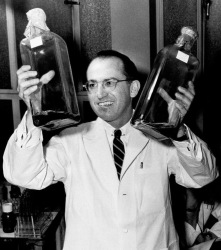In the early 1950s, the only thing scarier than the threat of nuclear war was the annual return of polio — an easily-spread, incurable disease that causes nerve damage, paralysis, and sometimes death. At the first sign of an outbreak, public hot spots like theaters and swimming pools would close up immediately.
One of the worst polio epidemics in the United States struck in 1952, a few years into the postwar baby boom. Polio is more likely to infect children than adults, so the race to create a vaccine reached a fever pitch.
Most researchers were looking into live-virus vaccines, which had worked nicely for smallpox and rabies and become the standard approach. But Jonas Salk, a medical researcher and budding virologist, was keen on the idea of safer, killed-virus vaccines. He believed the same principle would work for polio, and he was right. Within a few years of developing his vaccine, the number of polio cases in the United States dropped from ~29,000 in 1955 to less than 6,000 in 1957. By 1979, polio had been eradicated in the US.
Jonas Salk is one of science’s folk heroes. The polio vaccine was actually his sophomore effort — he and Thomas Francis developed the first influenza vaccine in the 1940s. And he didn’t stop with polio, either. Toward the end of his life, Salk was working on an AIDS vaccine.

A Doctor in the House
Jonas Salk was born in 1914 and raised in New York City. He was the oldest son of Russian-Jewish immigrants who didn’t have much money or education, but wanted the best for their children.
Salk has said in interviews that he was not interested in science as a child — he was “merely interested in things human”. The NYC polio epidemic of 1916 would have likely given Jonas an eyeful of humanity in the form of afflicted classmates with crutches and leg braces.
Jonas was a curious kid who read everything he could get his hands on. He had dreams of becoming a lawyer, but his mother wanted a doctor in the house. When Jonas was 13, he entered Townsend Harris High School, a public school for gifted students. Two years later at age 15, Jonas entered City College of New York (CCNY), where he would earn a Bachelor of Science in Chemistry. A fifteen-year-old college freshman at this competitive college was not particularly noteworthy, because many of the students there had skipped more than one grade.
After CCNY, Salk went to study medicine at NYU. It was here that he decided that although he liked medicine, he didn’t want to practice it. Salk was more interested in research. He believed he was meant to help humankind rather than treat the individual.

The Flu Fighters
For thousands of years, people believed influenza, or the flu, was caused by bacteria. The influenza virus was first discovered in the early 1930s, around the time Salk entered med school. In his senior year, he had a chance to spend time in a lab that was researching influenza, and he jumped on it. Salk believed that the virus strains could be effectively destroyed and still immunize, and he was eager to test this theory. As it turns out, he was right.
Salk did postgraduate work in virology, and spent some elective time in the laboratory of his mentor, Thomas Francis. It was here that he and Francis developed the first influenza vaccine by incubating a strain of the virus in a chicken embryo, then rendering it inactive.

Paralyzing Polio
Salk started his residency in Francis’ lab at Mount Sinai Hospital. Within a few years, he was eager to study infectious diseases in his own lab. He wouldn’t have to wait long. A man named Harry Weaver contacted him about researching polio. Weaver was director of research at the National Foundation for Infantile Paralysis, and was in a position to offer Salk his own lab and researchers. Soon, Salk started to get grants, which he used to build up his virology laboratory.
In 1947, Salk began working on a polio vaccine. First he had to sort out all 125 known strains of the virus. As he did, he noticed they all fell into one of three basic types. A successful vaccine would have to cover all three groups to give full protection from polio. Having figured this out, his next problem was making enough vaccine to experiment with. Luckily, in 1948, a group of scientists discovered that the polio virus would multiply just fine on scraps of non-nerve tissue from human embryos, meaning that a full-blown organism like a chicken embryo was not necessary. Thanks to this discovery, Salk could iterate much more quickly.
At the same time, another researcher named Albert Sabin was working on a live-virus vaccine to be taken orally. Sabin believed that only a live, weakened virus could make the human body produce antibodies, and believed that Salk was wasting his time trying to make an effective vaccine with dead strains.

The Polio Pioneers
In July 1952, Salk was ready to try out his killed-virus vaccine. His first patients were children who had already contracted polio and recovered. After vaccination, they all showed an increase in antibodies.
Then he tried the vaccine on himself, his wife, and his own children. When everyone in his family showed increased antibodies and no signs of illness, Salk knew it was time to share it with the world.
In 1953, Salk reported his results to the American Medical Association, and a massive trial was conducted the following year. One million children, known as the polio pioneers, were injected with Salk’s vaccine, and the results were incredible, with 60-70% prevention. The US wasted no time rolling out mass inoculations for children.
Unfortunately, there was an incident at one of the labs producing the vaccine. Some of the lots contained a live virus, and this mistake generated 40,000 new polio cases from the 120,000 poorly-controlled vaccines. The labs adopted higher standards and resumed production, but the incident would have a lasting impact on the pharmaceutical world. The news must have been bittersweet for Albert Sabin, who was still working on his live-virus version. Sabin completed human trials of his oral vaccine in 1957, and it was approved in 1962.

Could You Patent the Sun?
Once his vaccine was proven effective, Salk instantly shot to rock star status, much to his dismay. All the attention took time and energy away from his research, and he regretted losing his privacy and anonymity, especially where his research was concerned. Salk received a load of honors for his vaccine, including four honorary degrees and Presidential Medal of Freedom.
In an interview with Edward R. Murrow, he was asked who owned the patent on the vaccine. Salk famously replied, “Well, the people, I would say. There is no patent. Could you patent the sun?”
Though it’s easy to believe that Salk had completely altruistic intentions and never thought to patent it himself, it has since been discovered that the National Foundation for Infantile Paralysis’ lawyers had inquired about it at some point, and were told that the vaccine wasn’t novel enough to warrant a patent. Some would argue that the public had paid for it already through programs like the March of Dimes.

Giving Back: The Salk Institute
Salk was never in it for the money, and he never forgot where he came from. In 1963, he established the Salk Institute for Biological Studies in La Jolla, CA to provide a research space for scientists working toward the elimination of diseases like multiple sclerosis and cancer. The Salk Institute was the kind of place he could only dream of as a student.
Salk died of heart failure in 1995. Toward the end of his life, he had been working on vaccines for cancer, multiple sclerosis, and AIDS.
Jonas Salk had a huge impact on virology, on the United States, and on the longevity of thousands of baby boomers. The world could certainly use more scientists who follow his philosophy of helping humankind as a whole.
















“For thousands of years, people believed influenza, or the flu, was caused by bacteria.”
Seems a bit suspect since bacteria were only discovered in the 1600’s.
Sometimes I forget that they changed the site to non-engineering-scientific-contributor-biography-a-day
It’s one mighty hack for sure. I remember the excitement about this and those marks we all had on our shoulder.
I had both the oral and injectable form and no mark on my shoulder. You may be thinking about smallpox.
That was smallpox. The infection scar where live cowpox (or ?) was scratched into your skin with a bundle of sharp needles. My dad had a joke from the 1920’s. “I was vaccinated with a phonograph needle, but it didn’t affect me-affect me-affect me——“
My grandpa used to say I was vaccinated with a phonograph needle because I never shut up when I was a kid.
At best they only post these bios like once every 2-3 weeks, how’s that “changing” the site from the regular stream of hacks and projects it’s always hosted? In either case though, if you don’t like this particular content then just don’t click on and read it.
A-bloo-bloo-bloo. Keep scrolling
Thanks, didn’t want to be the first to point that out.
Then you get the nonsense replies of course “just don’t click on it then”. Kill the messenger, why don’t you?
And the obligatory, “it’s a hack because this scientist showed the hacking spirit”.
I’d rather get the “just don’t click on it then” replies then the even more useless complaining that you aren’t the center of the universe and every post has to bend to your interests. Seriously if you don’t like something on this site, shut it and get over yourself.
Using the same reasoning.. why does the author think she’s the centre of the universe, and bend this website’s purpose to swallow her off-topic posts?
… really?, because they are the author and the site’s owners have given them the green light to post this topic. You as a user don’t get to dictate what is on or off topic (only the site owners can do that), sure you can complain about it but it’s just gonna fall on deaf ears.
“For thousands of years, people believed influenza, or the flu, was caused by bacteria.”
That’s certainly a claim, not sure how well it works with things like “bacteria were only discovered in 1676” and “the germ theory of disease didn’t really kick off until Pasteur”.
Well.. he didn’t say “all” the people, just people. It’s those Victorian era time travelers. They settled everywhen and made all sorts of strange statements like this technically true.
Bringing two articles together … I used to skateboard that plaza from time-to-time.
I’ve washed sand off my feet in the ‘stream of life’ or whatever it’s called.
Amazing architecture, though.
Good Article, but should read ‘HIV Vaccine’ not AIDS
I always wanted a bumper sticker that read “Jonas Salk is my copilot”
First tried in ’52 and we haven’t wiped polio out yet, come on people.
Yes! We can deal with the plague after lunch.
Well we did wipe out smallpox so I really don’t seem the problem, polio isn’t aids.